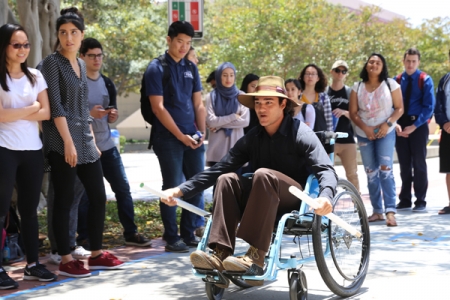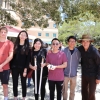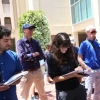Biomedical Engineering Students Design Lever Arm for Wheelchairs
 June 14, 2018 - More than 120 biomedical engineering students took on a challenge from the Free Wheelchair Mission (FWM), a nonprofit organization that provides free wheelchairs to impoverished people with disabilities in developing nations.
June 14, 2018 - More than 120 biomedical engineering students took on a challenge from the Free Wheelchair Mission (FWM), a nonprofit organization that provides free wheelchairs to impoverished people with disabilities in developing nations.
The FWM has been collaborating for several years with David Reinkensmeyer, professor of mechanical and aerospace engineering, and his graduate students. FWM founder and CEO Don Schoenderfer was excited to extend the challenge to undergraduates. He is interested in a design for a wheelchair lever driver to allow users to travel farther and more easily by reducing strain on upper extremity muscles. His company provided CAD designs and wheelchairs for students to use in developing their prototypes.
Christine King, assistant professor of teaching, taught the class, Engineering Analysis/Design: Computer Aided Design, which gave students 10 weeks to formulate teams, come up with a design and build a prototype. Each team had a $220 budget, with $71 designated for materials.
A lever driver would assist those who have upper extremity weakness and trouble using the traditional push rim. Students were instructed to design a lever arm that would enable wheelchair users to propel themselves forward and backward, stop and turn around without having to use the push rim.Schoenderfer was on hand for the final demonstration day. Twenty-one teams of five or six students tested their chairs by traveling 10 meters, up and back, and then spinning in place. “It was cool,” said Schoenderfer. “Lots of creative ideas. And what a great experience for these students; I can imagine them using these skills in their first job.”
Two teams stood out. The Wheelchair Master team traveled 10 meters in only 25 seconds. The Wheel Wizards team was able to do it in 40 seconds. Both had the best designs and prototypes, according to King.
“We used a gimbal ratchet, which allowed two-way rotation,” said Micah Lim, team leader for Wheelchair Masters. “One unintended benefit of our design was that it braked.”
On competition day, each team had 15 minutes to assemble their prototype before they took turns racing. Some never made it past the starting line.
The class taught the future engineers how to design in CAD software and how to translate those designs into a real-world prototype.
“For some students, this was the first time they've ever had to use tools and build something that moves,” explained King. “Much of what they learned is directly applicable to skills needed during their senior year design course as well as in industry, graduate school and as an entrepreneur.”
See more photos on our Facebook page.
– Lori Brandt


